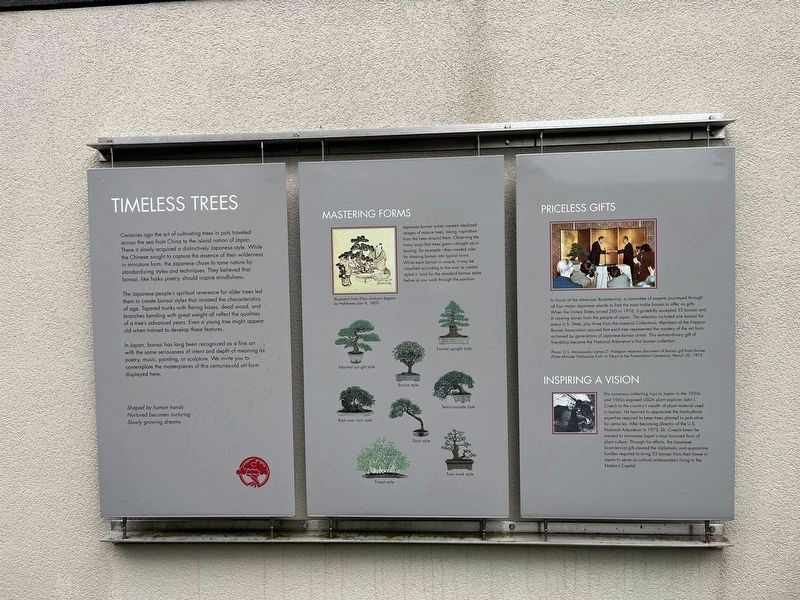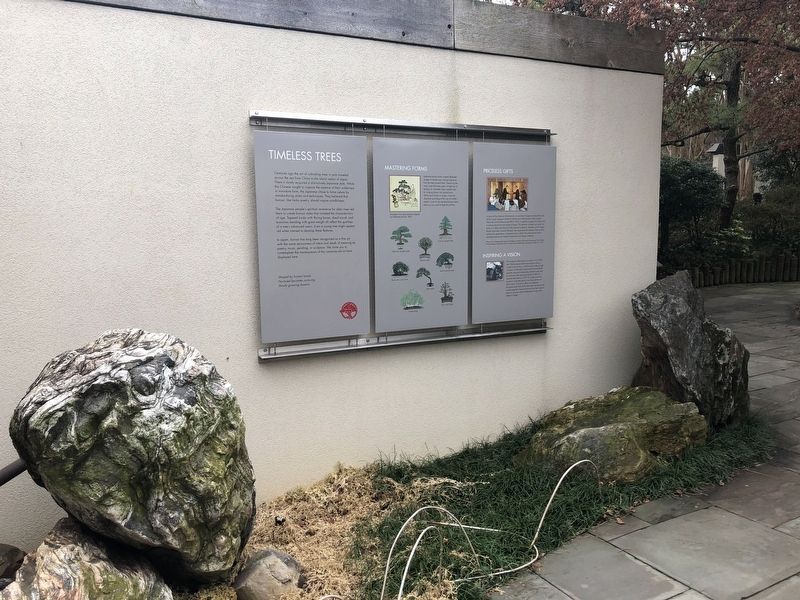National Bonsai Museum in Northeast Washington in Washington, District of Columbia — The American Northeast (Mid-Atlantic)
Timeless Trees
Centuries ago the art of cultivating trees in pots traveled across the sea from China to the island nation of Japan. There it slowly acquired a distinctively Japanese style. While the Chinese sought to capture the essence of their wilderness in miniature form, the Japanese chose to tame nature by standardizing styles and techniques. They believed that bonsai, like haiku poetry, should inspire mindfulness.
The Japanese people's spiritual reverence for older trees led them to create bonsai styles that imitated the characteristics of age. Tapered trunks with flaring bases, dead wood, and branches bending with great weight all reflect the qualities of a tree's advanced years. Even a young tree might appear old when trained to develop these features.
In Japan, bonsai has long been recognized as a fine art with the same seriousness of intent and depth of meaning as poetry, music, painting, or sculpture. We invite you to contemplate the masterpieces of this centuries-old art form displayed here.
Shaped by human hands
Nurtured becomes nurturing
Slowly growing dreams
Mastering Forms
Japanese bonsai artists created idealized images of mature trees, taking inspiration from the trees around them. Observing the many ways that trees grew—straight up or leaning, for example—they created rules for shaping bonsai into typical forms. While each bonsai is unique, it may be classified according to the way its creator styled it. Look for the standard bonsai styles below as you walk through the pavilion.
Priceless Gifts
In honor of the American Bicentennial, a committee of experts journeyed through all four major Japanese islands to find the most noble bonsai to offer as gifts. When the United States turned 200 in 1976, it gratefully accepted 53 bonsai and 6 viewing stones from the people of Japan. The selection is included one bonsai for every U.S. State, plus three from the Imperial Collections. Members of the Nippon Bonsai Association assured that each tree represented the mastery of the art form achieved by generations of Japanese bonsai artists. The extraordinary gift of friendship became the National Arboretum's first bonsai collection.
Photo: U.S. Ambassador James D. Hodgson receives document of bonsai gift from former Prime Minister Nobusuke Kishi in Tokyo at the Presentation Ceremony, March 20, 1975.
Inspiring A Vision
His numerous collecting trips to Japan in the 1950s and 1960s exposed USDA plant explorer John L. Creech to the country's wealth of plant material used in bonsai. He learned to appreciate the horticultural expertise required to keep trees
Erected by U.S. Department of Agriculture.
Topics. This historical marker is listed in these topic lists: Arts, Letters, Music • Horticulture & Forestry. A significant historical date for this entry is March 20, 1975.
Location. 38° 54.734′ N, 76° 58.147′ W. Marker is in Northeast Washington in Washington, District of Columbia. It is in National Bonsai Museum. Marker can be reached from Meadow Road Northeast just west of Ellipse Road Northeast when traveling west. Touch for map. Marker is at or near this postal address: 3501 New York Ave NE, Washington DC 20002, United States of America. Touch for directions.
Other nearby markers. At least 8 other markers are within walking distance of this marker. If trees could talk… (a few steps from this marker); National Bonsai & Pensing Museum (within shouting distance of this marker); Ellen Gordon Allen (within shouting distance of this marker); Branching Out (within shouting distance of this marker); Bonsai Pioneer (within shouting distance of this marker); "There are no borders in bonsai…" (within shouting distance of this marker); Rosmarinus officinalis (within shouting distance of this marker); An Art Form Is Born (within shouting distance of this marker). Touch for a list and map of all markers in Northeast Washington.
Credits. This page was last revised on January 30, 2023. It was originally submitted on January 11, 2020, by Devry Becker Jones of Washington, District of Columbia. This page has been viewed 198 times since then and 22 times this year. Photos: 1. submitted on October 2, 2022, by Devry Becker Jones of Washington, District of Columbia. 2. submitted on January 11, 2020, by Devry Becker Jones of Washington, District of Columbia.

